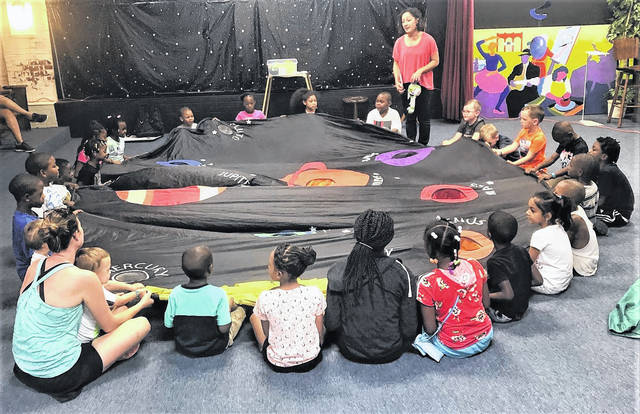North Carolina Cooperative Extension Agent Aimee Colf dropped by the Hampton B. Allen Library recently to teach children about the solar system.
Colf, who works with agriculture – horticulture and forestry at the Extension office, used props to teach them about the planets.
The children were overly excited to play Astronaut Andy with Colf, using the stuffed version of Buzz Lightyear from Toy Story. They gathered in a circle, with a parachute of nine planets in the middle of the circle; each with a hole for a special guest to land in.
Colf allowed the children to fly Buzz to each planet, after giving them facts about each planet. The children also were asked questions about each planet, including the former planet, Pluto.
“He’s a little bitty planet, who’s no longer a planet because he has not cleared his orbit,” Colf said. “He’s still working on it.”
Mercury is the smallest planet, and the planet closest to the sun.
Venus is the hottest planet, and can be 860 degrees F. It is the brightest planet and the same size as Earth.
“Venus has an atmosphere of a lot of sulfur and carbon dioxide,” Colf said.
Earth is the only planet with liquid water on it’s surface, and the only planet that has life.
“We all know mars as the Red Planet,” Colf said. “Even though it’s a red planet, it is a lot cooler than earth is.”
Mars’ temperature regularly drops to minus 125 degrees F, or minus 82 degrees C in the winter; and only rises to 23 degrees F, or minus 5 degrees C.
“If you’ve ever seen a picture of Jupiter, it has these big red spots on it,” Colf said. “That’s because Jupiter has storms.”
Jupiter is the biggest planet in the solar sytem, and the home of the Great Red Spot. It is also the first of the gas planets.
Saturn is the only planet that has rings; the second biggest planet in the solar system.
Uranus has the coldest atmosphere; with temperatures as low as -280 degrees F. It also has a strange rotation because it is the only planet that rotates on its side.
“It has 27 moons; and it’s made out of rock, ice, water, methane, and amonium, so it’s just gassy,” Colf said.
Colf went on to say, “next, we’re going to a big Ice Giant.”
Neptune is the third largest planet. It is the coldest planet — twice as cold as Earth at minus 150 degrees F.
Although it was once considered the ninth planet, Pluto is now known as a dwarf planet.
“Maybe when it makes its obit, Pluto will be a planet again,” Colf said to the children.
After sending Buzz on another trip through the solar system, they listened to the “Outer Space Solar System Super Song,” from the Netflix series, “Ask the StoryBots.”
Destiny Dows, children librarian, added that the goal was, “to learn at least one fact about the planets in our solar system, and to know what order they go in.”

Colf plays Astronaut Andy with children using Buzz Lightyear.
